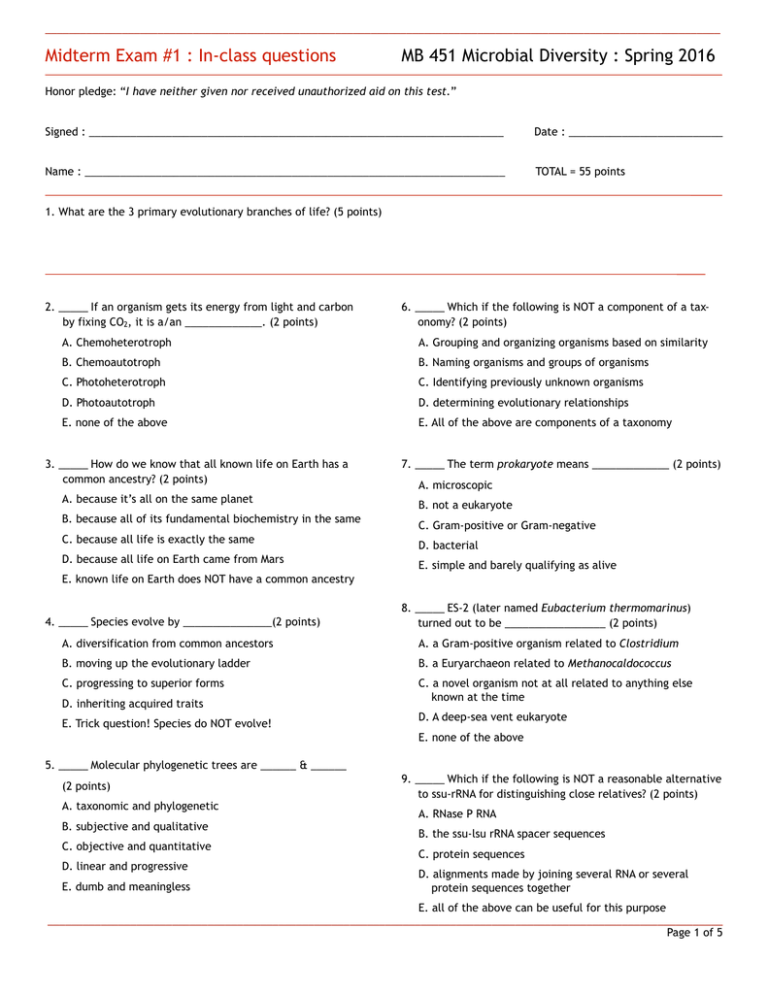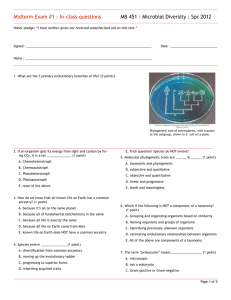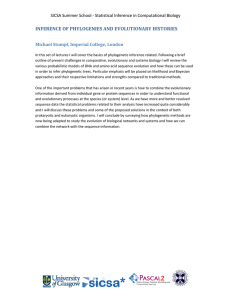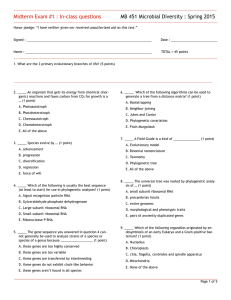Document 14580108
advertisement

__________________________________________________________________________________________________________________ Midterm Exam #1 : In-class questions MB 451 Microbial Diversity : Spring 2016 Honor pledge: “I have neither given nor received unauthorized aid on this test.” Signed : ______________________________________________________________________ Date : __________________________ Name : _______________________________________________________________________ TOTAL = 55 points 1. What are the 3 primary evolutionary branches of life? (5 points) 2. _____ If an organism gets its energy from light and carbon by fixing CO2, it is a/an _____________. (2 points) 6. _____ Which if the following is NOT a component of a taxonomy? (2 points) A. Chemoheterotroph A. Grouping and organizing organisms based on similarity B. Chemoautotroph B. Naming organisms and groups of organisms C. Photoheterotroph C. Identifying previously unknown organisms D. Photoautotroph D. determining evolutionary relationships E. none of the above E. All of the above are components of a taxonomy 3. _____ How do we know that all known life on Earth has a common ancestry? (2 points) A. because it’s all on the same planet B. because all of its fundamental biochemistry in the same C. because all life is exactly the same D. because all life on Earth came from Mars 7. _____ The term prokaryote means _____________ (2 points) A. microscopic B. not a eukaryote C. Gram-positive or Gram-negative D. bacterial E. simple and barely qualifying as alive E. known life on Earth does NOT have a common ancestry 4. _____ Species evolve by _______________(2 points) 8. _____ ES-2 (later named Eubacterium thermomarinus) turned out to be _________________ (2 points) A. diversification from common ancestors A. a Gram-positive organism related to Clostridium B. moving up the evolutionary ladder B. a Euryarchaeon related to Methanocaldococcus C. progressing to superior forms C. a novel organism not at all related to anything else known at the time D. inheriting acquired traits E. Trick question! Species do NOT evolve! D. A deep-sea vent eukaryote E. none of the above 5. _____ Molecular phylogenetic trees are ______ & ______ (2 points) A. taxonomic and phylogenetic B. subjective and qualitative C. objective and quantitative D. linear and progressive E. dumb and meaningless 9. _____ Which if the following is NOT a reasonable alternative to ssu-rRNA for distinguishing close relatives? (2 points) A. RNase P RNA B. the ssu-lsu rRNA spacer sequences C. protein sequences D. alignments made by joining several RNA or several protein sequences together E. all of the above can be useful for this purpose __________________________________________________________________________________________________________________ Page 1 of 5 __________________________________________________________________________________________________________________ 10. _____ Which if the following is NOT true of “horizontal transfer”? (2 points) 13. _____ Which of the following is NOT a major lesson drawn from the “Big tree” of life? (2 points) A. Big eukaryotes represent a small portion of diversity A. was more common before the last common ancestor B. Chloroplasts are bacterial endosymbionts B. occurs between organisms of all phylogenetic distances C. Gram-positive/negative are not the major divisions oF Bacteria C. is most frequent between close relatives D. probably is not a major factor in microbial evolution E. All of the above are true 11. _____ What is the purpose of bootstrapping? (2 points) A. to determine the reliability of branches in a tree B. to convert a similarity matrix into a distance matrix C. an algorithm used to generate phylogenetic trees D. a method of calculate ancestral sequences E. none of the above 12. _____ Which of the following is an important feature of a useful molecular clock? (2 points) A. Functional constancy B. Comprised of a large number of independently-evolving units C. Large database of sequences and resources D. Not (often) transferred horizontally E. all of the above D. Mitochondria are bacterial endosymbionts E. protists (unicellular eukaryotes) evolved from Bacteria 14. _____ The “universal tree” was rooted using _________ (2 points) A. the fossil record B. small-subunit ribosomal RNA C. ancient duplicated genes D. Archaea as the outgroup E. none of the above 15. _____ Archaea are most closely-related by ancestry (i.e. have a common ancestor with) to ____________________ (2 points) A. Viruses B. Bacteria C. Eukarya D. mitochondria E. none of the above __________________________________________________________________________________________________________________ Page 2 of 5 __________________________________________________________________________________________________________________ 16. Answer the following questions from this ssu-rRNA-based tree (2 points each) Pectinatus sottaceto Evolutionary distance 77 71 0.01 substitutions/position 100 100 76 69 Pectinatus haikarae Pectinatus sp. TY 100 100 100 100 66 73 Pectinatus portalensis 100 100 Megamonas rupellensis Megamonas funiformis Megamonas hypermegale 95 100 Selenomonas ruminantium Megasphaera cerevisiae 97 100 Veillonella atypica Sporomusa silvacetica Bacillus subtilis Uppper numbers : Maximum Likelihood bootstrap values (% of 1000 trees, rounded to nearest %) Lower numbers : Weighted neighbor-joining bootstrap values (RDP, % of 100 trees) a. Which sequence is most similar to that of Megamonas hypermegale? _______________________________________________ b. What is the outgroup? _______________________________________________________________________________________ c. Which is the least primitive sequence (excluding, perhaps, the outgroup)? __________________________________________ d. Circle the least-reliable branch on the tree and label it “D”. e. What is the approximate evolutionary distance between Pectinatus sp TY and M. rupellensis? _________________________ f. Circle the last common ancestor of the genus Megamonas and label it “G”. g. If another specie of Selenomonas were added to this tree, draw what it might look like (on the tree above). __________________________________________________________________________________________________________________ Page 3 of 5 __________________________________________________________________________________________________________________ 17. On the tree in question above, what does the number “76” mean above the branch leading to P. portalensis and P. haikarae mean? How was this number determined? Be sure to both give it’s name and describe the process. (5 points) 18. Given that you must have an outgroup to root a tree, how was the “universal” phylogenetic tree rooted? (3 points) __________________________________________________________________________________________________________________ Page 4 of 5 __________________________________________________________________________________________________________________ Use this page to complete any answers you need extra space for. XKCD.COM __________________________________________________________________________________________________________________ Page 5 of 5 __________________________________________________________________________________________________________________ Midterm Exam #1 : Take-home questions MB 451 Microbial Diversity : Spring 2015 Honor pledge: “I have neither given nor received unauthorized aid on this test.” The rules: You are free to use any notes, books, or online material while taking this take-home exam. You are also free to use a calculator and ruler or other drawing material. You are NOT allowed to get (or give) help of any kind from (or to) anybody. If you have questions about the exam, send an email to Dr. Brown at james_brown@ncsu.edu. You MUST turn this completed take-home portion of the exam in no later than when the start of the rest of the exam. Signed : ______________________________________________________________________ Date : __________________________ Name : _______________________________________________________________________ TOTAL = 55 points 1. Align the following sequences: (5 points) B. anthracis A U G A G A C U U G C A A U B. brevis A C G A G A C C A U G C A A B. cereus A C G A G A U C U G C A A U B. diminuta A G A G A C U U G U A A U 2. Align the following RNAs: (5 points) A A G U A C U U G U U C - G C - G G - C A - U G - C A - U A - U A - U A - U C - G A U C - G A - U A U Escherichia Hafnia Erwinia U __________________________________________________________________________________________________________________ Page 1 of 5 __________________________________________________________________________________________________________________ 3. Draw the secondary structure of the C. rattus RNA in this alignment: (5 points) ( ( ( ( ( - - - - - ) ) ) - - ) ) - - C. suis G G A C - C U U A A - G U - - C C U A A C. rattus C C G C C U U C - G G G U A A G G U U - U U A C A C - G A - U G - C G - C U A A C. suis 4. Convert this phenogram into a dendrogram. Please keep the tree to the same scale. (5 points) 5. Use the following distance matrix to generate a tree (with branch lengths) using the neighbor-joining method. SHOW ALL OF YOUR WORK! (15 points) A B C D E A - - - - - B 0.3 - - - - C 0.8 0.9 - - - D 0.6 0.7 0.8 - - E 0.4 0.5 0.8 0.6 - __________________________________________________________________________________________________________________ Page 2 of 5 __________________________________________________________________________________________________________________ CONTINUE YOUR WORK ON QUESTION 5 HERE XKCD.com __________________________________________________________________________________________________________________ Page 3 of 5 __________________________________________________________________________________________________________________ 6. You have cultivated an unknown organism from your skin and have obtained its ssu-rRNA sequence. After running a couple of preliminary trees, you’ve zoomed it down to the following tree of relatives: Bacillus thuringiensis Staphylococcus epidermidis Vagococcus elongatus Enterococcus casseliflavus Aerococcus sanguinicola Lactococcus lactis Pediococcus acidilactici UNKNOWN ORGANISM Lactobacillus vaginalis Lactobacillus acidophilus Lactobacillus gasseri Leuconostoc mesenteroides Erysipelothrix rhusiopathiae Eubacterium barkeri Peptostreptococcus anaerobius Clostridium acetobutylicum Veillonella atypica Heliobacillus mobilis Streptomyces lividans Based on this tree, make 5 independent, specific, testable predictions about the properties of your organism. (2 points each) 6a. 6b. 6c. 6d. 6e. __________________________________________________________________________________________________________________ Page 4 of 5 __________________________________________________________________________________________________________________ EXTRA CREDIT! 7. For up to 2 extra-credit points, list a couple of specific properties of your unknown that your tree does not allow you to predict with any confidence: (1 point each) 7a. 7b. __________________________________________________________________________________________________________________ XKCD.com Page 5 of 5






